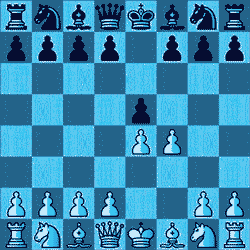King's Gambit - Deadly Traps
by Jeff Ackermann
(Vancouver, Canada)
The King's Gambit was the most popular openings for over 300 years, and has been played by many of the strongest players, in many of the greatest brilliancies, including the Immortal Game.
Everyone loves chess traps and every chess player has fallen into a chess trap. A chess trap refers to a situation where a player goes wrong through his own effort, leading to a loss of a piece or the game. Perhaps a player captures an "innocent" pawn, and, as a result, the game is lost. It was a poisoned pawn, and another victim has fallen for chess trap. The trapped player did not notice anything special, but the position suddenly became lost.
Masters and grandmasters have fallen for opening traps. This shows that all players must consider knowing opening traps; how to set them and how to avoid them.
There is much potential for tactical maneuvers and traps in the King's Gambit. The thing with the King's Gambit is, a lot of the time White has to accept they won't be able to castle, its simply part of the opening.

Deadly Traps in the King's Gambit
In reality 1.e4 e5 2.f4 exf4 3.Bc4 Qh4+ is not a very dangerous idea for Black. After 4.Kf1 Nf6 5.Nc3 Black can't force through d5 immediately because the Queen isn't on d8 anymore (and in fact, for the sake of that check is very awkwardly placed) where as White can look forward to playing Nf3 gaining tempo by chasing away the Queen. If left undisturbed moves like d4 will follow, threatening Bxf4 (depending on where Black's Queen has gone) getting the pawn back with a huge lead in development.
Here is a very exciting King's Gambit Game from about 50 years ago:
Spassky,Boris V - Bronstein,David I
C36
USSR Championship Leningrad, 1960
1.e4 e5 2.f4
White offers the King's Gambit.
2...exf4
Black accepts.
3.Nf3
Preventing the queen from coming to h4 delivering a check.
3...d5
Attempting to open up a line on the king.
4.exd5 Bd6
Supporting the advanced pawn and taking advantage of the cover offered by the enemy pawn on d5.
5.Nc3?! Ne7
Development from both sides.
6.d4
White has good control in the center now.
6...0-0
Black is castled but his queenside is almost completely undeveloped.
7.Bd3
Taking up a nice position. As White develops, all of his pieces will be staring down on the Black king.
7...Nd7 8.0-0
As often happens in the King's Gambit, when White is allowed to castle, the rook immediately enjoys an open file on the f-file.
8...h6
Weakening the defense in front of the king but he wants to control g5.
9.Ne4
White's following combination will allow him to get all of his pieces in good positions, while Black's pieces will be cramped.
9...Nxd5 10.c4 Ne3 11.Bxe3 fxe3 12.c5 Be7 13.Bc2
Making way for the queen to get on to the diagonal with a huge threat.
13...Re8 14.Qd3 e2 15.Nd6!
Deeply calculated.
15...Nf8
h7 must be covered.
16.Nxf7!
Giving up the rook but maintaining the initiative.
16...exf1Q+ 17.Rxf1 Bf5 18.Qxf5 Qd7
Black would love to trade queens but it's not going to happen.
19.Qf4 Bf6
Cutting off the knights support.
20.N3e5
Re-establishing the link and chasing the queen.
20...Qe7 21.Bb3
Preparing a discovered check.
21...Bxe5 22.Nxe5+ Kh7 23.Qe4+
Resigns as the Black's fate is sealed.
(23.Qe4+ g6 24.Rxf8 Qg7 25.Rf7 Qxf7 26.Bxf7 Rg8 27.Nxg6 Kg7 28.Ne5 Kh8 29.Qf4 Rxg2+ 30.Kxg2 Kg7 31.Qg4+ Kf8 32.Qg6 Ke7 33.Qe6+ Kf8 34.Qf6 Re8 35.Ng6#) 1-0
Play through the game move by move.
More on the King's Gambit.
Comments for King's Gambit - Deadly Traps
|
||
|
||







